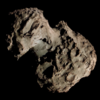 Time-lapse with an 8" Celestron telescope on July 14, 2022 - the night of its closest approach to Earth. Below the comet is the Globular Cluster Messier 10. | |
| Discovery | |
|---|---|
| Discovery date | 21 May 2017[1] |
| Orbital characteristics | |
| Epoch | 2022-12-07 (2459920.5) |
| Observation arc | 9.46 years |
| Number of observations | 477 |
| Orbit type | Oort cloud |
| Aphelion | ~50000 AU (inbound)[2] ~1400 AU (outbound)[2] |
| Perihelion | 1.7969 AU[3] |
| Eccentricity | ~0.99992 (inbound) ~0.9975 (outbound)[2] |
| Orbital period | Millions of years inbound[2] ~19,000 years (outbound)[2] |
| Inclination | 87.563° |
| 88.26730 | |
| Last perihelion | 19 December 2022[3][4][a] |
| Earth MOID | 1.10 AU (165 million km) |
| Jupiter MOID | 1.29 AU |
| Physical characteristics | |
| Dimensions | Rn between 14 km (8.7 mi) and 80 km (50 mi)[5] maximum Dn ~18 km (11 mi)[6] |
C/2017 K2 (PanSTARRS) is an Oort cloud comet with an inbound hyperbolic orbit, discovered in May 2017 at a distance beyond the orbit of Saturn when it was 16 AU (2.4 billion km) from the Sun. Precovery images from 2013 were located by July.[7] It had been in the constellation of Draco from July 2007 until August 2020. As of June 2022[update], the 3-sigma uncertainty in the current distance of the comet from the Sun is ±6000 km.[8]
The comet is record breaking because it was already becoming active at such a distance. Only Comet Hale–Bopp produced such a show from that distance with a similar nucleus. However, this comet will not be as visible as Hale–Bopp was in 1997 in part because it does not come nearly as close to the Sun.[b] Astronomers had never seen an active inbound comet this far out, where sunlight is 1/225th its brightness as seen from Earth. Temperatures, correspondingly, are at -440 °F (-262 °C) in the Oort cloud. However, as it was approaching the Sun at a distance of 16 AU at discovery, a mix of ancient ices on the surface containing oxygen, nitrogen, carbon dioxide and carbon monoxide began to sublimate and shed the dust frozen into it. This material expands into a vast 130,000 km (81,000 mi) wide halo of dust, called a coma, enveloping the solid nucleus.[9] Outgasing of carbon monoxide was detected when the comet was 6.72 AU from the Sun.[10]
Research with the Canada–France–Hawaii Telescope (CFHT) infers the comet nucleus to have a radius between 14–80 km (9–50 mi), so there is a chance the nucleus could be as large as C/1995 O1 (Hale-Bopp).[5] However, research with the Hubble Space Telescope (HST) estimates the nucleus to have a circular equivalent diameter of less than 18 km (11 mi).[6] On 17 September 2020, morphological studies of the inner coma, observed on 12 September 2020, were reported, noting that two jet-streamed structure were emitted from the nucleus and, as well, that the length of the tail was about 800,000 km (500,000 mi) long.[11]
The comet was within 5 AU (750 million km) of Earth by 11 January 2022.[12] Around 6 July 2022, the comet crossed the celestial equator, and then on 14 July 2022, it passed 1.8 AU (270 million km) from Earth[13] and shone around 9.0 magnitude making it a decent binoculars object.[14][4] It reached perihelion on 19 December 2022, close to the orbit of Mars, and was not visible to naked eye at 8.0 magnitude.[3][4][a]
On 27 July 2021, further detailed observations of the comet were reported on The Astronomer's Telegram.[15][16]
JPL Horizons models that C/2017 K2 took millions of years to come from the Oort cloud at a distance of roughly 50,000 AU (0.8 ly).[2] The heliocentric orbital eccentricity drops below 1 in December 2023.[17] The outbound orbital period will be around 19000 years with aphelion being around 1400 AU.[2] There was a dispute whether that was the first time the comet entered the inner solar system, but its orbit suggests that the comet isn't dynamically new and there is a 29% chance that the comet is of interstellar origin and was captured by the solar system within the last 3 million years.[18]
![June 2017 by Hubble's Wide Field Camera 3[19]](https://upload.wikimedia.org/wikipedia/commons/thumb/e/e6/Distant_active_comet_C_2017_K2.jpg/120px-Distant_active_comet_C_2017_K2.jpg)





